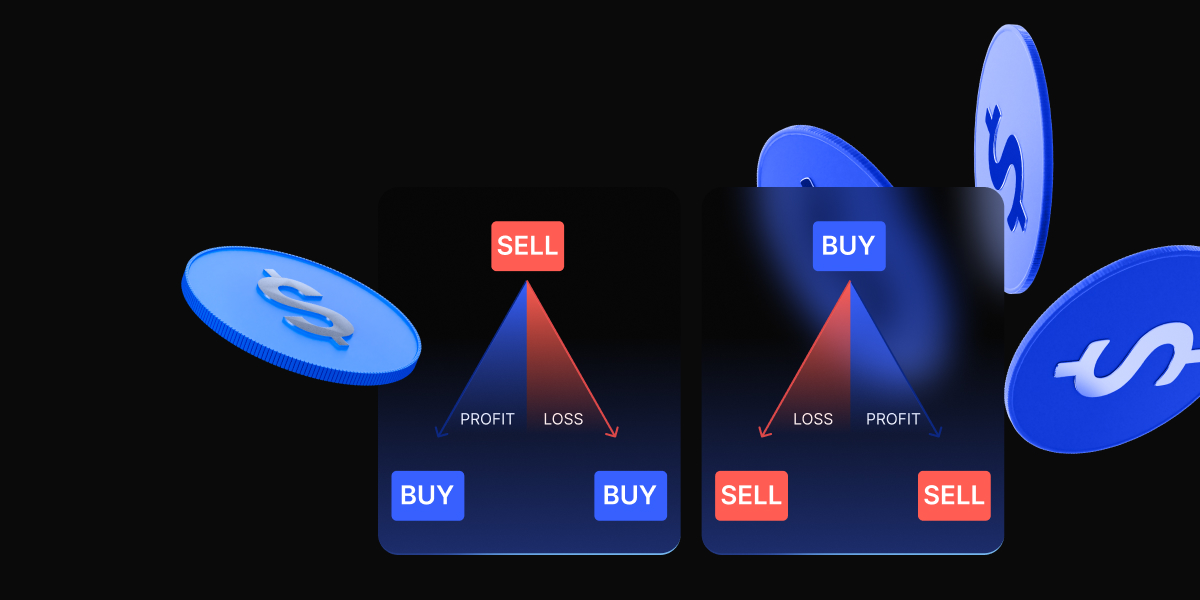Bearish candlestick patterns are essential tools in technical analysis, providing traders with visual cues about potential market downturns. These patterns are formed by specific arrangements of candlesticks and signal selling pressure and a possible shift in market sentiment from bullish to bearish. Understanding and interpreting these patterns can significantly enhance a trader’s ability to anticipate price declines and make informed trading decisions.
Key takeaways
- Bearish candlestick patterns indicate potential price declines.
- They help traders anticipate market downturns and plan trades strategically.
- Combining these patterns with technical indicators enhances their reliability.
- Effective risk management is crucial when trading based on bearish patterns.
What is a bearish candlestick pattern?
Definition: A bearish candlestick pattern visually represents a market sentiment that suggests a potential price decline. These patterns are formed by the arrangement of candlesticks on a price chart, where each candlestick represents the open, high, low, and close prices for a specific period. Bearish patterns typically indicate that sellers gain control, leading to a potential downward trend.
Importance in trading: Bearish candlestick patterns are crucial for traders as they provide early warning signs of potential market downturns. By identifying these patterns, traders can strategically plan their trades, such as exiting long positions or entering short positions, to capitalise on anticipated price declines. These patterns also help traders manage risk by setting appropriate stop-loss and take-profit levels.
Psychological edge: Finally, recognising bearish candlestick patterns gives traders a psychological edge. Knowing they can anticipate market downturns gives traders confidence in their decision-making processes. This confidence can reduce emotional trading, often leading to impulsive and irrational decisions. By relying on the objective signals provided by bearish candlestick patterns, traders can maintain a disciplined approach, leading to more consistent and successful trading outcomes.
Bearish vs. bullish reversal patterns
Bearish reversal patterns indicate a shift from bullish to bearish sentiment, signalling potential price declines. On the contrary, a bullish reversal pattern indicates a shift from bearish to bullish sentiment, signalling potential price increases.
6 Powerful Bearish Candlestick patterns
In this section, we’ll explore key bearish reversal patterns.
1. Hanging Man
The Hanging Man is part of bearish reversal patterns that appear at the end of an uptrend. It has a small real body and a long lower shadow, indicating that sellers pushed prices lower during the session, but buyers managed to bring the price back up. However, the long lower shadow suggests that selling pressure is increasing, potentially leading to a price decline.

Example: Imagine a stock in an uptrend where a Hanging Man pattern is formed. The next day, the stock opens lower, confirming the bearish reversal pattern. Traders might consider exiting long positions or entering short positions.
2. Dark Cloud Cover
The Dark Cloud Cover is a two-candlestick pattern that signals a bearish reversal. The first candlestick is bullish, followed by a bearish candlestick that opens above the previous day’s high but closes below its midpoint. This pattern indicates that sellers have taken control, potentially leading to further price declines.
Example: A stock in an uptrend forms a Dark Cloud Cover pattern. The bearish candlestick’s close below the midpoint of the previous bullish candlestick suggests a shift in sentiment. Traders might look for confirmation before making trading decisions on the next trading day.
3. Bearish Engulfing
The Bearish Engulfing pattern consists of two candlesticks: a small bullish candlestick and a larger bearish engulfing candle that completely engulfs the previous one. The bearish engulfing candlestick pattern indicates that sellers have overwhelmed buyers, suggesting a potential reversal to the downside.
Example: A stock in an uptrend forms a Bearish Engulfing pattern. The large bearish candlestick engulfs the previous bullish candlestick, signalling strong selling pressure. Traders might consider shorting the stock or exiting long positions.
4. The Evening Star
The Evening Star is a three-candlestick pattern that signals a bearish reversal. It consists of a large bullish candlestick, a small-bodied candlestick (indicating indecision), and a large bearish candlestick. This pattern suggests that the uptrend is losing momentum, and a reversal is likely.

Example: A stock in an uptrend forms an Evening Star pattern. The small-bodied candlestick indicates indecision, and the subsequent large, bearish candlestick confirms the reversal. Traders might look for further confirmation before taking action.
5. The Three Black Crows
The Three Black Crows pattern consists of three consecutive bearish candlesticks with long bodies and short or no shadows. This pattern indicates strong selling pressure and a potential reversal from an uptrend to a downtrend.
Example: A stock in an uptrend forms the Three Black Crows pattern. The three consecutive bearish candlesticks suggest sustained selling pressure, so traders might consider shorting the stock or exiting long positions.
6. Bearish Harami
A bearish harami is a two-bar Japanese candlestick pattern that signals a potential reversal from a bullish to a bearish trend. It consists of a long-bodied bullish (green or white) candle followed by a smaller bearish (red or black) candle, where the second candle’s body is entirely contained within the body of the first candle.
This pattern typically forms at the top of an uptrend, indicating that the buying momentum is waning and sellers may soon take control. The term “harami” means “pregnant” in Japanese, reflecting the visual appearance of the pattern, where the smaller second candle is “inside” the larger first candle, resembling a pregnant woman.
Example: Consider a stock that has been in a strong uptrend with a series of bullish candles. One day, a long green candle forms, followed by a smaller red candle the next day, which opens and closes within the range of the previous green candle.
This formation suggests the bullish momentum is weakening, and a potential reversal to the downside may occur. Traders often use additional technical indicators, such as the Relative Strength Index (RSI) or Moving Average Convergence Divergence (MACD), to confirm the bearish harami pattern before making trading decisions.
Reading and interpreting bearish patterns
Identifying patterns
To identify bearish candlestick patterns, traders should look for specific formations on price charts. Each pattern has unique characteristics, such as the length of the candlestick bodies and shadows, the position of the candlesticks relative to each other, and the overall trend context.
Contextual analysis
Interpreting bearish patterns requires understanding the broader market context. Bearish patterns are more significant after an uptrend, indicating a potential reversal. Traders should also consider the pattern’s interaction with key support and resistance levels, as patterns near these levels can have stronger implications.
Confirmation
Confirmation is crucial when interpreting bearish patterns. Traders should look for additional signals, such as increased trading volume or corroborating technical indicators, to validate the pattern’s significance. This helps reduce the risk of false signals and enhances the reliability of trading decisions.
Common mistakes when identifying bearish candlestick patterns
There are several common mistakes traders make when identifying bearish candlestick patterns. These mistakes can significantly impact their trading performance and lead to potential losses. Here are some of the key errors:
- Over-relying on candlestick patterns: One of the most frequent mistakes is over-relying without considering other factors. Traders often focus solely on the patterns and ignore broader market conditions, such as economic news, market trends, and company fundamentals. This can lead to inaccurate predictions and missed opportunities.
- Ignoring the overall trend: Another common mistake is ignoring the market as a whole. Candlestick patterns are most effective when used with the prevailing market trend. For instance, if the overall trend is bullish, looking for bearish patterns might lead to false signals and unnecessary losses. Traders should always consider the broader market context to validate their observed patterns.
- Misinterpreting patterns: Misinterpretation of candlestick patterns is a significant issue. Not all patterns are reliable indicators of market movements, and sometimes they can be misleading. For example, a Doji pattern typically indicates indecision in the market but does not always signal a reversal. Traders must take a holistic approach, considering other indicators and market conditions to confirm or refute a pattern’s significance.
- Neglecting confirmation signals: Failing to wait for confirmation signals is another common mistake. Traders often rely solely on the appearance of a specific candlestick pattern without waiting for additional confirmation, such as a break of a trendline or a close above a resistance level. This can lead to false signals and unsuccessful trades. Waiting for confirmation can help reduce the likelihood of errors and increase the probability of successful trades.
Technical analysis using bearish patterns

Combining bearish patterns with technical indicators
Enhancing the reliability of bearish candlestick patterns involves combining them with other technical indicators. Common indicators include the Relative Strength Index (RSI), Moving Average Convergence Divergence (MACD), and Moving Averages. These indicators provide additional insights into market conditions and help confirm bearish signals.
Example: A Bearish Engulfing pattern forms on a stock chart. The RSI also shows overbought conditions, and the MACD indicates a bearish crossover. These additional signals confirm the bearish pattern, increasing the likelihood of a price decline.
Interaction with key market levels
Bearish patterns often interact with key support and resistance levels. When a bearish pattern forms near a resistance level, it suggests that the level is holding and a price decline is likely. Conversely, if a bearish pattern forms near a support level, it may indicate that the support is weakening, leading to further price declines.
Example: A stock forms a Dark Cloud Cover pattern near a significant resistance level. The pattern suggests the resistance is holding, and the stock will likely decline. Traders might consider shorting the stock with a stop-loss above the resistance level.
Trading strategies based on bearish patterns
Short selling
Short selling is a common strategy for capitalising on anticipated downward movements. Traders borrow shares and sell them at the current price, aiming to buy them back at a lower price in the future. Bearish candlestick patterns provide signals for when to enter short positions.
Example: A stock forms a Bearish Engulfing pattern. Traders might short the stock, anticipating a price decline. To manage risk, they can set a stop-loss above the high of the engulfing candlestick.
Risk management
Effective risk management is crucial when trading based on bearish patterns. Traders should set stop-loss orders to limit potential losses and take profit points to secure gains. The placement of these orders depends on the pattern and the overall market context.
Example: A stock forms an Evening Star pattern. Traders might set a stop-loss above the pattern’s high and a take-profit point at a recent support level. This ensures that potential losses are limited while allowing for profit-taking if the price declines.
Entry and exit points
Determining the best times to enter and exit trades based on bearish patterns involves analyzing the pattern’s formation and confirmation. Traders should wait for the pattern to fully form and look for additional confirmation before entering a trade. Exit points should be based on key support levels or other technical indicators.
Example: A stock forms a Hanging Man pattern. Traders wait for the next candlestick to confirm the pattern before entering a short position. They set a stop-loss above the high of the Hanging Man and a take-profit point at a recent support level.
H2: Pros and cons of using bearish candlestick patterns
Pros
- Early warning signs: Bearish patterns provide early signals of potential price declines, allowing traders to take proactive measures.
- Enhanced risk management: These patterns help traders set appropriate stop-loss and take-profit levels, improving risk management.
- Suitability for various trading styles: Bearish patterns can be used in different trading styles, including day trading, swing trading, and long-term investing.
Cons
- Potential for false signals: Bearish patterns can sometimes produce false signals, especially in volatile markets. Additional confirmation is necessary to reduce this risk.
- Dependency on market conditions: The effectiveness of bearish patterns depends on the overall market context. They are more reliable in trending markets and less so in choppy or ranging markets.
Conclusion
Bearish candlestick patterns are invaluable tools for traders. They provide insights into potential price declines and help anticipate market downturns. By understanding and interpreting these patterns, traders can make informed decisions, manage risk effectively, and capitalise on downward price movements. Combining bearish patterns with other technical indicators and considering the broader market context enhances their reliability and effectiveness.
The content provided here is for informational purposes only. It is not intended as personal investment advice and does not constitute a solicitation or invitation to engage in any financial transactions, investments, or related activities. Past performance is not a reliable indicator of future results.
The financial products offered by the Company are complex and come with a high risk of losing money rapidly due to leverage. These products may not be suitable for all investors. Before engaging, you should consider whether you understand how these leveraged products work and whether you can afford the high risk of losing your money.
The Company does not accept clients from the Restricted Jurisdictions as indicated in our website/ T&C. Some services or products may not be available in your jurisdiction.
The applicable legal entity and its respective products and services depend on the client’s country of residence and the entity with which the client has established a contractual relationship during registration.




